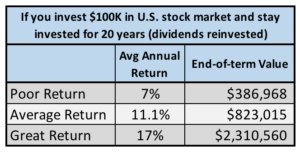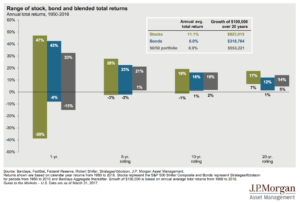… but only in the short run.
As we saw in this previous post, stocks go down 10% or more every year. More often than not, they also recover quickly. So what return could we expect in a given year? Here is a good chart from J.P. Morgan. It shows the range of annual returns that U.S. stocks and bonds have achieved over 1, 5, 10, and 20–year periods.
If you invest your money for just one year, you can expect a wide range of returns from stocks: from a gain of 47% to a loss of 39%. Put it in bonds and you are far safer – your maximum loss could only be 8%. So, unless you know something that other investors don’t, it is probably not worth your while to invest in stocks if you need the money back in one year.
Now consider keeping your money invested in stocks for five years instead. Your possible downside is about the same as if you invested this money in bonds. Your maximum upside is higher though – 28% for stocks versus 23% for bonds. But also note (from the same chart) that average annual return for stocks is 11%. So even though your possible worst-case return could be negative 3%, most of the time you will do far better than that. Even if those five years involve a bear market. You’ve got nothing to lose!
Same argument applies if you invest your money in stocks for 10 years. You have got almost no downside (worst-case loss of 1%) but your upside could be as high as 19%.
I only invest in stocks that I intend to keep for at least five years. In my stock portfolio, majority of positions are held for five years, if not longer. When I start a new position, I fully expect it to turn negative sometimes during its first year. Seldom do I benefit from perfect timing! But if I pick wisely, its five-year return would handily beat the market. Monitoring stock prices on daily or even weekly basis serves no good purpose any ways. See this post on why it’s not healthy to check stock prices every day.
If you are disciplined enough to stay invested for 20 years or more, you literally have nothing to lose! Since 1950, there has not been a single 20-year period in the U.S. stock market where investors have lost money. Instead, you would have gotten a positive annual return ranging from a low of 7% to an average 11% and as high as 17%.
To put it another way, if you had invested $100,000 in the U.S. stock market any time after 1950 and left it there for 20 years, your return would have been in this range:

That poor return ain’t too shabby either! You still would have quadrupled your money. But there is a good chance that you’d have made much more than that. Up to 23 times your original investment!
Embrace the volatility.
If you are going to invest your savings in the stock market, you must come to terms with the up-and-down nature of it. Expect down years – even multiple down years in a row. Expect multiple up years too – like the recent run. In the short term, you will always be at the mercy of prevailing sentiment.
Too many people are afraid to dip their toes in the stock market because they are unsure where the market will go next. They are afraid they will regret it if they invest today. But they also don’t know what tomorrow might bring.
Market changes directions. High growth periods lead to slow growth periods. Down years lead to up years. Negative returns are followed by positive returns. Pessimism replaces optimism. And vice versa.
You just don’t know the exact timing though. Stay invested for the long-run (at least five years) and you won’t need to.
Famed investor and writer Howard Marks in his book, The Most Important Thing, calls this group of investors the “I don’t know” school:
Join the “I don’t know” school … You’ll soon tire of saying “I don’t know” to friends and strangers alike. After a while, even relatives will stop asking you where you think the market’s going.

[…] is to ride out market declines. Don’t panic and don’t pay attention to the financial press. Stocks are volatile but only in the short term. Give yourself three to five years – most bear markets don’t last even half that […]